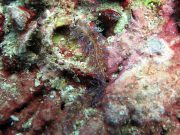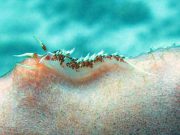Dykning med Facelinidae Nøgensnegle
Koh Lantas Marineliv | Facelinidae
Facelinidae Nudibranchs er farverige aeolid nudibranchs, der findes på alle dykkersteder omkring Koh Lanta.
Medlemmer af superfamilien af aeolide nøgensnegle har mange tilspidsede blodfyldte rør, der vokser fra kroppens dorsale (ryg) og laterale (side) områder. Disse gevækster kaldes 'cerata'..
Cerata har flere funktioner og indeholder en kanal fra fordøjelseskirtlen. Disse tyndvæggede, blodfyldte strukturer fungerer også som gæller, og for de arter, der spiser koraller og anemoner, er der en giftig stikkende sæk i spidsen af cerata, der bruges til forsvar.
Da en stor del af farven på disse nøgensnegle afhænger af farven på cerata, som igen også er påvirket af kosten, kan medlemmer af denne familie skifte farve afhængigt af, hvad de spiser.
Facelinidae Nøgensnegle har normalt en lang, udstrakt krop (langstrakt), hvor cerata normalt er arrangeret i buer eller rækker. De fleste arter i denne familie lever af hydroider, hvorfra de udvinder de stikkende kemikalier til brug i deres defensive stiksække.
2 arter fundet på denne side:
Blue Dragon
(Pteraeolidia ianthina)

Pteraeolidia ianthina @ Koh Bida
The Blue Dragon has an extremely long body with many clusters of cerata. Adults are of variable colouring, with blue to violet bands on the rhinophores (pair of tentacles on the head).
As juveniles, Blue Dragons are actually white, however as they grow, they seek out certain species of hydroids which contain particular zooxanthellae. The Blue Dragons consume the hydroids, extracting the zooxanthellae which are then stored within the cerata and live symbiotically with the Blue Dragon.
Through photosynthesis, the zooxanthellae provide both the colour (as they do with corals) and a large amount of sugars and nutrients for the Blue Dragon. Due to differences in the zooxanthellae, Blue Dragons can have a variable colour, however all species have blue to violet bands the tips of the rhinophores.
The Blue Dragon grows to 10 cm
Indian Phidiana
(Phidiana indica)

Phidiana indica @ Koh Haa
The Indian Phidiana has an opaque to translucent orangish head, with white lines. The distinctive cerate (blood-filled tubes growing from the back and sides) have a reddish base, followed by a blue band, and finally with a whitish or yellowish tip.
The Indian Phidiana grows to 5 cm.
The diet consists mostly of hydroids Salacia tetracythara and Pennaria sp.
Dykning med Facelinidae Nøgensnegle omkring Koh Lanta
Dykning og snorkelture
Hvis du gerne vil have chancen for at se Facelinidae Nøgensnegle på en af vores daglige dykkerture i højsæsonen fra Koh Lanta, så send os en e-mail til info@diveandrelax.com.
Deltag i vores speedbådsdykkerture i højsæsonen til nogle af Thailands bedste dykkersteder og nyd små grupper, korte rejsetider med fokus på god personlig service, sikkerhed og sjov.
Er du endnu ikke certificeret dykker? Lær at dykke på Koh Lanta med det 3-dages SSI Open Water Diver-kursus.
Book online og spar 10% på dykkerture og dykkerkurser på Koh Lanta.
Få mere at vide
Indo-Stillehavets havdyrsguider
- Allen, G., Steene, R., Humann, P., DeLoach, N. (2003) Reef Fish Identification, Tropical Pacific. Jacksonville, FL., USA: New World Publications, Inc., ISBN 1-878348-36-1.
- Humann, P., DeLoach, N., (2010) Reef Creature Identification, Tropical Pacific. Jacksonville, FL., USA: New World Publications Inc., ISBN 978-1-878348-44-9
- Debelius, H. (2013) Indian Ocean Reef Guide. Frankfurt, Germany: IKAN - Unterwasserarchiv, ISBN 978-3-939767-52-7.
- Debelius, H. (2004) Nudibranchs and Sea Snails, Indo-Pacific Field Guide. Frankfurt, Germany: IKAN - Unterwasserarchiv, ISBN 3-925919-51-1
- Erhardt, H., Knop, D. (2015) Corals Indo-Pacific Field Guide. Frankfurt, Germany: IKAN - Unterwasserarchiv, ISBN 3-925919-69-4.
- Veron J.E.N., Stafford-Smith M.G., Turak E. and DeVantier L.M. (2016). Corals of the World
Flere referencer om havets dyreliv og yderligere information
